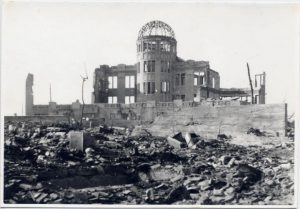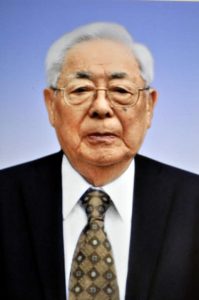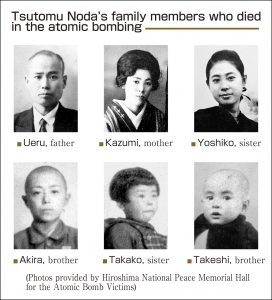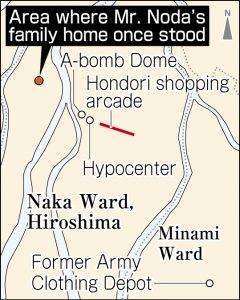Striving to fill voids in Hiroshima, evidence of victims remains 76 years after atomic bombing—Photos of A-bombing destruction, Part 7: Route of work commute captured by Tsutomu Noda
Dec. 11, 2021
Photos of ruined city where six family members perished
Sorrow endures in personal notes
by Kyosuke Mizukawa, Staff Writer
In 2006, Tsutomu Noda, who lived in Nishinomiya City in Hyogo Prefecture, donated five photographs taken some time in the fall of 1945 to the Hiroshima Peace Memorial Museum, located in the city’s Naka Ward. Mr. Noda’s photos included shots of the largely destroyed Hiroshima Prefectural Industrial Promotion Hall (now the A-bomb Dome) and the Hondori shopping arcade, where only rubble remained. His photos at the time attracted little notice because shots taken by members of the public at the same locations already existed.
Nevertheless, reading through the personal notes left by Mr. Noda, who died four years ago at the age of 92, this reporter became aware of how irreplaceable the five photos truly are. In 1986, he wrote 39 pages of notes for his family titled “Thoughts about August 6, 41 years ago.” Kazutaka Kato, 72, Mr. Noda’s cousin who lives in Hiroshima’s Minami Ward, allowed me to peruse Mr. Noda’s notes that had been kept by the family but never shown to the public.
Commuting to the Army Clothing Depot
Before the atomic bombing, Mr. Noda’s family operated a clothier in the area of Nishihikimido-cho (now Tokaichi-machi in Hiroshima’s Naka Ward). His family was composed of seven people. The oldest of five brothers and sisters, Mr. Noda worked at the former Army Clothing Depot (now in the city’s Minami Ward), but in February 1945, the 20-year-old Mr. Noda was transferred to a branch workplace in neighboring Shimane Prefecture’s Izumo City.
On August 4, 1945, he returned home to Hiroshima on a three-day, work-related trip. On the morning of August 6, the entire family gathered together around the breakfast table. “I never imagined it would be the last time I saw them” (as recounted in Mr. Noda’s notes). Mr. Noda walked through the city and arrived at the Clothing Depot before 8:00 a.m. He was situated in the red-brick warehouse.
Just then, according to Mr. Noda’s account, “a strange light poured in through the iron-barred windows.” After helping the wounded who had fled to the Clothing Depot, 2.6 kilometers from the hypocenter, he headed to the city center “with the sole desire of seeing his family.” He was unable to approach his home, however, because the area was in flames.
With that being the final day of his military work trip, he returned to Izumo City. On August 16, the day after Japan’s official surrender in the war, he returned to Hiroshima City again on a work-related trip, with the “dream of meeting my family.” That dream was shattered, however, when a relative informed him that his mother Kazumi, 42, his brothers Akira, 13, and Takeshi, 2, and his sister Takako, 4, had been killed in the atomic bombing at their home, about 700 meters from the hypocenter. His father, Ueru, 48, who was attending a funeral in the neighborhood at the time, was missing. Mr. Noda wrote in his notes that, amid the ruins of his home, “I shed tears in front of the remains of my mother, brothers, and sisters, whose appearance had been completely altered.”
Sister, who escaped immediate death, also ended up dying
His only surviving family member, 17-year-old Yoshiko, was taken to the Kusuna National School (now Kusuna Elementary School, in Hiroshima’s Minami Ward) near a relative’s house. She had managed to escape from their collapsed home, but “could do nothing to help other members of the family, who yelled, ‘Help me’ and ‘It’s so hot.’” Mr. Noda wept as his sister conveyed the story.
His sister was unable to walk on her own, so Mr. Noda stayed by her side all night, fanning her in hopes she would recover. He was determined to survive with his sister by providing each other with support. However, spots began to appear on her body and her hair fell out. Yoshiko died on August 23. “I wish she was still alive,” he wrote in his notes, which speak of a grief that never dissipated.
After the war, Mr. Noda lived in Yamaguchi and Hyogo prefectures, locations to which he was transferred by his company. When his cousin Mr. Kato was a child, Mr. Noda would stay at his house every summer to commemorate the date of the atomic bombing of Hiroshima. “He was usually a calm, collected person, but he would wail in front of the television on the morning of August 6 every year at the time of the annual Peace Memorial Ceremony broadcast.”
Mr. Kato originally advised Mr. Noda to donate the five photos to the museum in order to leave them to future generations. According to his notes, on that day, August 6, Mr. Noda commuted to the Clothing Depot, traveling past the Hiroshima Prefectural Industrial Promotion Hall (now the Atomic Bomb Dome, in present-day Naka Ward) and walking through the Hondori Shopping arcade. That route matches up with the five photos that he took of the area.
Although details of his photography are unclear, Mr. Noda might have taken the photos later based on his memories of August 6. The photos provide evidence that the man, alone and separated from all six other members of his family, confronted the reality of the city still scarred by the atomic bombing. I wanted to consider Mr. Noda’s A-bombing experiences and emotions by weaving together the photos and the descriptions he inscribed in his notes from that time.
(Originally published on December 11, 2021)











